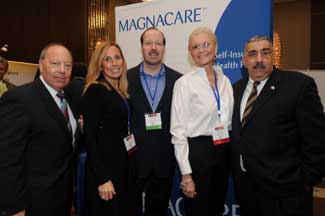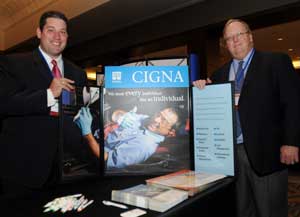November 8, 2011
by Marc Bussanich, LaborPress City Reporter
About 50 providers of healthcare services and investment managers in the union trust fund industry recently exhibited at the 18th Annual Health & Benefits Expo organized by the Teamster Center Services (TCS). The exhibitors’ diversity ranged from health insurance companies to software companies that develop specific applications that help union welfare funds gain detailed insights into their members’ health issues.
Andrew Johnson is the administrator for TCS, which provides critical referral services to Teamster members and their families in need of mental health or substance abuse support and care. TCS provides these services to 28,000 families covered by the 17 Teamster benefit funds.
According to Johnson, the turnout by trustees and administrators of multi-employer and public sector health funds at this year’s expo was one of the best ever. “The attendees were very eager to learn from the exhibitors how their specific products and services can help union members stay healthy.”
One of the exhibitors, HealthCare Strategies, Inc., has been in the healthcare business for almost 30 years. The company’s specialty is a software analytic tool that clients such as hospitals, municipalities, school districts, employers and union trust funds use to identify which of their employees need more healthcare guidance because they are suffering from chronic illnesses like diabetes.
The unique tool collects data from multiple streams such as hospital, physicians and pharmacy claims. Janice Albert, President, CEO of HealthCare Strategies, explained that the company’s software platform, the Health Manager Dashboard, allows hospitals, for example, to learn more about a patient’s healthcare actions, or lack of, outside of their facility. “The data contained in submitted claims is the data we collect, which gives hospitals a more comprehensive view of the patient,” said Albert.
Albert noted one of the challenges of working with a Teamsters union is that many Teamsters are out on their delivery routes or work long hours, which makes it difficult to contact them and to know which doctors or physicians they may be visiting while in transit.
 She said the data gleaned from the submitted claims allows a union fund administrator(s) to make the decision to impose a $500 deductible on patients who are not following up with outreach calls from nurses or other clinical staff or haven’t visited a pharmacist to refill their medications.
She said the data gleaned from the submitted claims allows a union fund administrator(s) to make the decision to impose a $500 deductible on patients who are not following up with outreach calls from nurses or other clinical staff or haven’t visited a pharmacist to refill their medications.
The company’s platform and technology has helped clients save millions of dollars. “Anybody who has a health plan and is spending too much money is a prospective new client,” noted Albert.
She mentioned a particular Teamster trust fund that was losing money because it did not have the means to track how members were utilizing healthcare services. After implementing HealthCare Strategies technology platform, the fund administrator told Janice that it reaped $74 million in savings because the data allowed the fund’s nurses and clinical staff to proactively reach out to members and members’ doctors to ensure that members were following through on instructions to refill medication or schedule a follow-up doctor’s visit.
HealthCare Strategies started to license its platform this year, and based on the experience of the Teamsters trust fund, Albert believes that as other organizations implement the platform, they should expect to see significant savings as well.
Her company’s technology may be one of the untold stories during the debate leading up to passage of the 2010 Affordable Care Act. Albert said she is not concerned, so far, of the implications of the new federal law, or the recently enacted single-payer health care system in Vermont. Instead, she’s optimistic that the company will be able to win new business with either model because the technology satisfies either model’s quest to keep healthcare costs low while providing quality care.
Another exhibitor at the Health & Benefits Expo was Tony Potenza, the executive director of the New York Labor Health Care Alliance, a purchasing cooperative for 35 union benefits funds who receive preferred pricing, because of their collective purchasing power, on a range of healthcare solutions such as comprehensive health benefit plans (i.e., Aetna Labor Plan), or prescription-benefit plans managed by Medco.
Potenza said the alliance seeks to consistently add new funds each year. Sometimes potential new funds worry they might be merged with other funds in the alliance. But Potenza stressed that all funds retain their autonomy in how their administrators craft their health plans or use the services the alliance has been able to secure with different providers and vendors. And, Potenza tells prospective new members, “Even if you don’t want to avail yourself of the negotiated services, being a member of the alliance gives you a seat at the table to hear from other union trust fund administrators ideas on how to preserve dollars and provide quality care.”
Potenza didn’t provide specific dollar amounts an individual union trust fund can save by joining the alliance. But he noted as an example that many of the 35 funds have purchased fiduciary liability insurance the alliance secured from a provider and saved significantly. “A fund administrator told me that since his plan utilized the alliance-endorsed insurance, his plan pays about the same for two years’ worth of the insurance that it paid for one years’ coverage with another carrier.”
Potenza said there’s been no direct negative impact from “Obamacare,” but noted that one provision in the law to provide coverage to dependents up to age 26 has “gotten the attention of many funds.” “The union trust fund managers are in support of the provision, but it does require that they scrutinize their dollar spend.”
 The most challenging aspect of running a labor healthcare alliance is ensuring that “the providers and vendors, who really want to do business with the alliance because of the sheer number of total participants, are offering value-added products,” said Potenza. Sometimes a provider is not prepared to offer a benefit to the alliance that an individual trust fund couldn’t secure on its own, according to Potenza. “The principle reason why a particular provider will be listed with us is that it can offer a popularly used product or service at a discounted rate.”
The most challenging aspect of running a labor healthcare alliance is ensuring that “the providers and vendors, who really want to do business with the alliance because of the sheer number of total participants, are offering value-added products,” said Potenza. Sometimes a provider is not prepared to offer a benefit to the alliance that an individual trust fund couldn’t secure on its own, according to Potenza. “The principle reason why a particular provider will be listed with us is that it can offer a popularly used product or service at a discounted rate.”
As 2012 nears, the alliance is preparing for a new product rollout. A new data-warehousing program will enable the alliance to collect and store on central servers statistics and data the individual trust funds generate, such as length of hospital admissions, which will help fund managers craft and design their plans before submitting them out to bid. Also, the alliance will be offering its member funds insurance-related products for plan participants on a voluntary basis.



